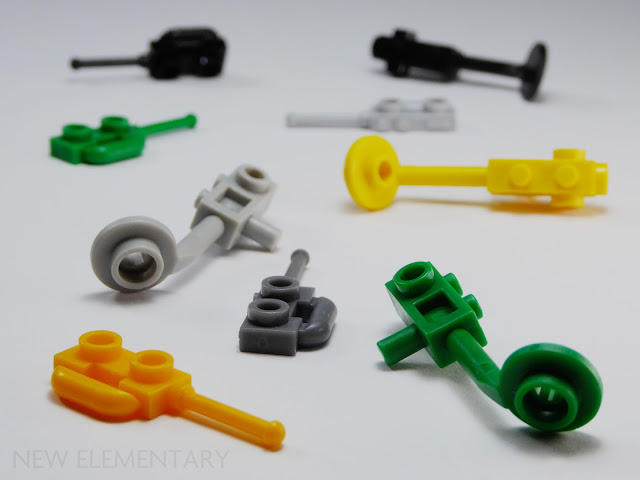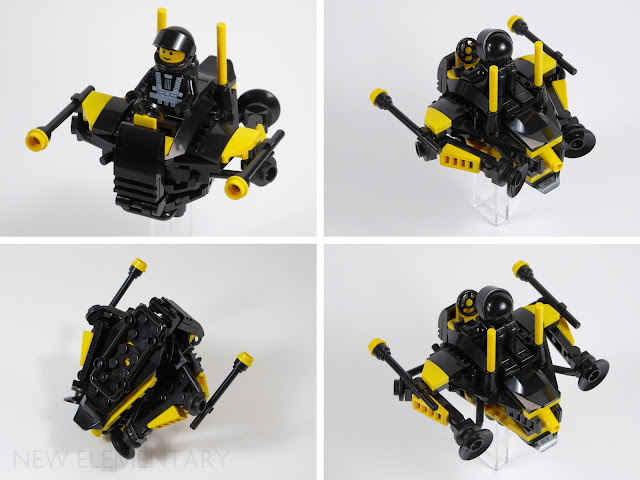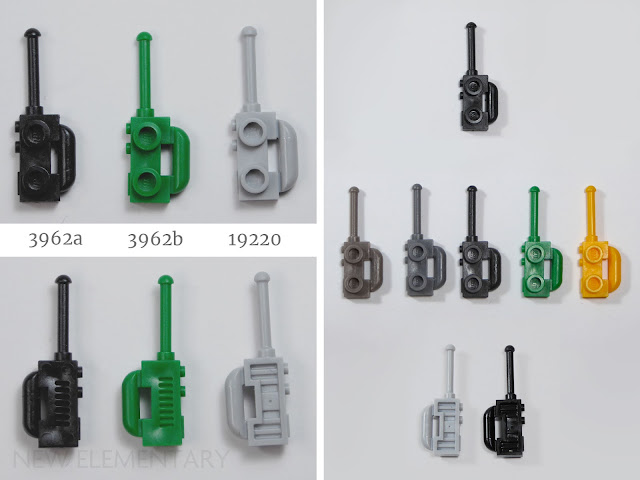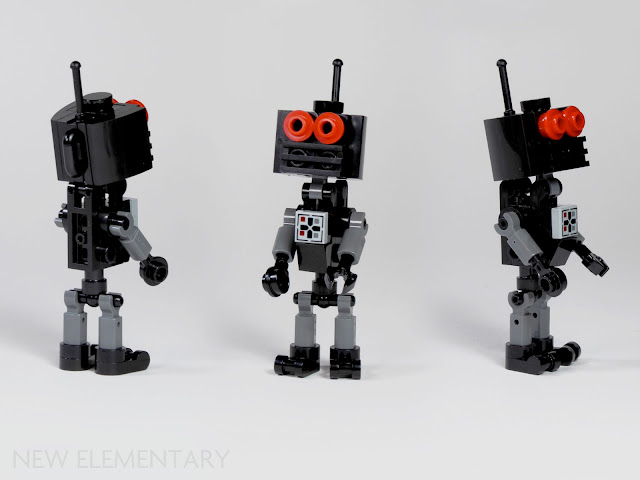From the selected tools I chose the Metal Detectors 4479 & 93106 and Radios 3962a, 3962b and 19220 as well as the 'T' Bar 84868.
To start, I have some thoughts to share on my chosen tools and the MOCs I've fashioned with them. I also have a few final details on some of the elements that the eagle-eyed amongst you might be thinking we have not yet featured from our original list!
Metal Detectors
By 1983, my team of spacemen had already been on so many missions it's hard to believe the Metal Detector had not been featured in a set until that year. I very clearly remember getting 6844 Seismologic Vehicle and instantly loved the Metal Detectors. You got two in Light Grey! The Black variety was only available in some of that year's other LEGO Space sets and you only got one: 6980 Galaxy Commander, 6930 Space Supply Station, 6823 Surface Transport, 6701 Minifigure Pack and 6711 supplementary spacemen.
It's also surprising that it's only been in a total of 36 sets in 3 colours. A Dark Grey variant has been logged as being included as an alternate colour in certain supplementary packs - 5157 Town and Space Tools and 5177 Town and Space Equipment - but I have never seen one and currently there is only one I can find that's for sale. Please let us know in the comments if you have a Dark Grey one, especially if you know where it came from. Of course, other colours have been known to fall into the hands of collectors!
The Metal Detector was updated in 2013 to bring it more "in System" with three major changes.
- The hollow stud and anti-stud were removed from the head.
- The hole at the handle end has an inner ring that now prevents us pushing a 3.18 bar all the way through.
- The two 3.18 diameter 'buttons' on the top face were realigned so that they fit into hollow studs.
There are also some subtle
fillets added to the interface between stem and head.
It might be my nostalgia for the original but I tend to feel that more connection points (even if they're not 100% "in System") are better. Obviously, more connections means more possibilities and I feel that the Metal Detector is diminished in its potential as a result of the changes wrought to its form.
Certainly this rocket owes much to the odd connections that are made possible by the unusual angle the Metal Detector head is set at and that the 3.18 hole through it allows for further possible connections.
Equally, my Angle-poise wouldn't have the same feel (nor would it be possible to make) without the idiosyncrasies of the original geometry.
This is actually the first Blacktron-style ship I've built. The Metal Detectors allowed for some SNOT building and can be sandwiched. Some rotation is also possible using this method so my Blacktron 'Detector' has an attack position!
Let's all just hope that the Spider-tector doesn't also have an attack position! Spider joke incoming: It's a Metalomorph! (
Mygalomorph spiders include Taranulas and Funnel Webs).
Radios
The Radio varies very little in its 3 forms. The handle (how close it is to the body) and the number of speaker vents on the back had been the only differences up until 2011. The 19220 remould very subtly changed the overall length, diameter of the aerial and the vents on the back. 3962a only ever came in Black, 3962 racked up 5 colours and currently 19220 has appeared in just two colours since its introduction.
I found the radio to be far more challenging to use in interesting ways than I had expected to. It is locked as a right-handed item, there are no anti-studs and although the two studs are hollow, many of the parts I attached failed to yield pleasing results. Connecting via the 3.18 handle also made for quite limiting opportunities, though I'm sure there are still far more interesting ways to use the part than I managed.
So I have to admit to only using the radio in two of my MOCs and you'll need to look pretty close to see it in the first as they're mostly hidden by all the metal detectors!
These are clearly Gear-aniums, The question for me is do you water or oil them? In fairness, I think this MOC owes much, much more to the Metal Detector in its inspiration than the Radio.
However, this little robot was inspired by and entirely the result of sandwiching a radio in the hope of using the aerial as an antennae. I've just realised, this guy is Radiohead! I wonder if he's a Paranoid Android?
'T' Bar
As outlined in our intro article, the T-bar is available in just one set currently, 71397 Luigi's Mansion Lab and Poltergust, and has just one of this fantastic new piece included. I sincerely hope it finds its way into other sets and colours. Two modules wide, one module deep and just over five and a half plates high. A 3.18 hole in either side, an anti-stud in the base, a 3.18 stem and a 3.18 bar at the top. This piece really isn't lacking in connection points!
The T-bar is hiding as hips in this Junior (Iron Giant-ish) Robot. And yes, those eyes are the DB5 headlights, unceremoniously harvested from the Speed Champions 76911 007 Aston Martin
I reviewed in July. I'd wanted an excuse to use them like this and I was pleased that the opportunity presented itself here. DB-5 would be a great Star Wars droid name but he looks more like a Futurama kind of robot to me. Perhaps he's owned by A stern Martian?
Not that it isn't usually, but Classic Space is on all our minds right now - owing to the recent release of the delightful 10497 Galaxy Explorer (expertly
reviewed by Caz). My excitement for that set is palpable and I couldn't resist building a reimagined version of 894/452 Mobile Ground Tracking Station to go with it.
In an attempt to find another use for the 'T' bar I inadvertently made a speeder. I also felt that I hadn't really used the updated Metal Detector so I made a companion (or rival) speeder to go with it!
Leftovers
While we don't have a MOC for every space tool on our original list, here's a quick overview of the remaining ones.
Three of the four above have changed very little in the forty years we've had them in our toolbox. Round ends may have been flattened, injection point locations may have changed, but essentially they are the same today as when they would have dropped out of a box emblazoned with a yellow "LEGOLAND" banner.
The pickaxe has in fact changed very slightly, however I couldn't verify precisely when that occurred. The older mould (at rear) was still in use in 1992 with the release of 6247 Bounty Boat. By the time the colour changes from the old grays happened (circa 2003) the mould had been updated and 4754 Hagrid's Hut from that time appears to show the newer style.
Conclusion
Wow, what a great Parts Fest this has been!
The Space Tools provided us with some very interesting building options. Even if we didn't find entirely new ways to use them, I feel that we demonstrated once again that a seemingly single purpose LEGO® element has the potential to be used creatively in a number of unusual applications.
I've been thrilled and delighted by all the contributions both by our regular team members and our guest contributors. Who knew such a wide array of things were possible using the humble Spaceman's exploration utensils? I hope our readers have enjoyed this as much as I have and thank you to all the contributors for all the hard work and wonderful creations.
Editor: Chris Baginski
READ MORE: See what Ryan Harkin made from the space tools
Help New Elementary keep publishing articles like this. Become a Patron!
Massive thanks go to our 'Vibrant Coral' patrons: Antonio Serra, Beyond
the Brick, Huw Millington, Big B Bricks, Dave Schefcik, David and Breda
Fennell, Richard Selby, Gerald Lasser, Baixo LMmodels, Markus
Rollbühler, Elspeth De Montes, Chuck Hagenbuch, Megan Lum, Andy Price,
Jf, Daniel Church, and Amy Hays.
LEGO® Shop at Home
USA: FREE SHIPPING every day on orders over $35!
UK: Free delivery when you spend £50 or more at LEGO!
Australia:
Discover the latest promotions and offers on LEGO.com
All text and images are © New Elementary unless otherwise attributed.




















This whole series has been wonderful, thanks to all the contributors.
ReplyDeleteYour Blacktron Detector really has the look of an official set, nice job!
Seeing the back of the radio robot's head makes me want to experiment more with having the radio handle as a styling element. Multiple in a row could look very cool as a surface radiator or ladder rungs or ?The way it transitions from bar diameter then tapers softly into the body is unique to Lego. I get the sense if they made this piece today the handle would be more of a straight cylinder with squared ends.
Thanks for the kind words, glad you've enjoyed it :-)
DeleteI wanted to sandwich more of the radios together to create a radiator surface as you suggest, but the support structures I tried for more than two or three became a bit unwieldy.
Of course, this is LEGO, so I fully expect there are better ways I didn't think of!
In terms of the usefulness of the radio, I found it useful in places where I needed a 1x2 plate with hollow studs on the underside of something, such as offsetting a 1xX piece by 1/2 of a stud. While 35480, the 1x2 plate with rounded corners, makes this application obsolete in the current palette, I can't deny that the radio used to make some mech limbs possible that may not have been otherwise.
ReplyDeleteThe hollow studs are great for that kind of half plate step!
DeleteThe yellow metal detector is apparently a rare test part, while the green metal detector only appeared in the Toy Story set 7595 Army Men on Patrol.
ReplyDeleteThere are also red and blue available from tests or 'Q' list parts - if you have deep enough pockets! The real mystery is the original dark grey variation.
DeleteThe Dark Grey ones may be the same - I have some 1x1 corner panels in Dark Grey of similarly mysterious origin.
Deletenice
ReplyDelete